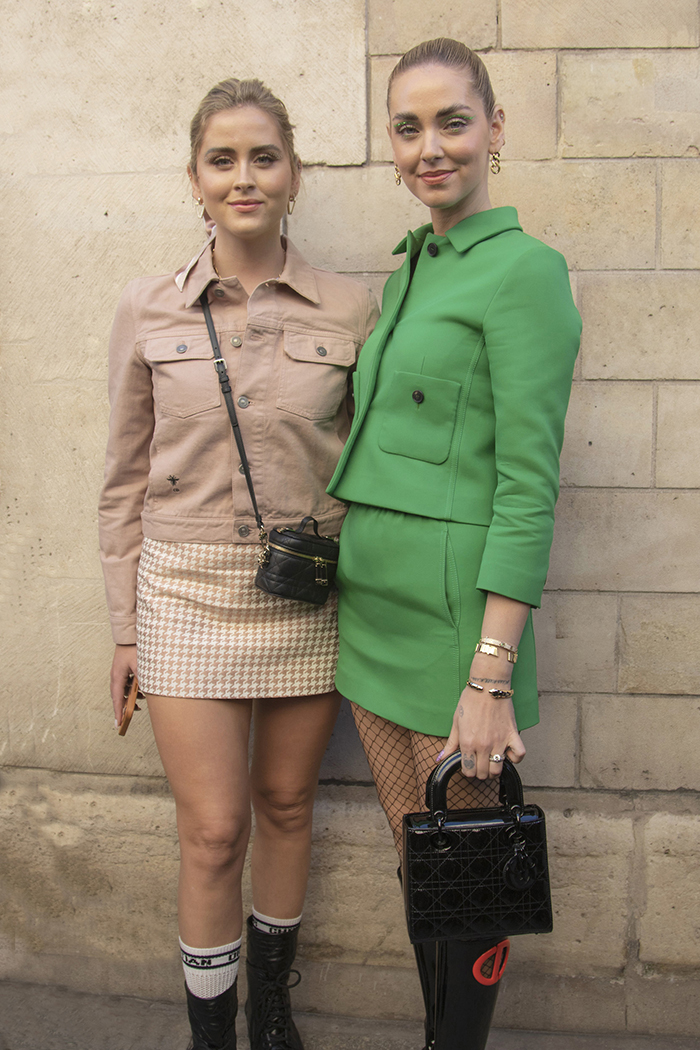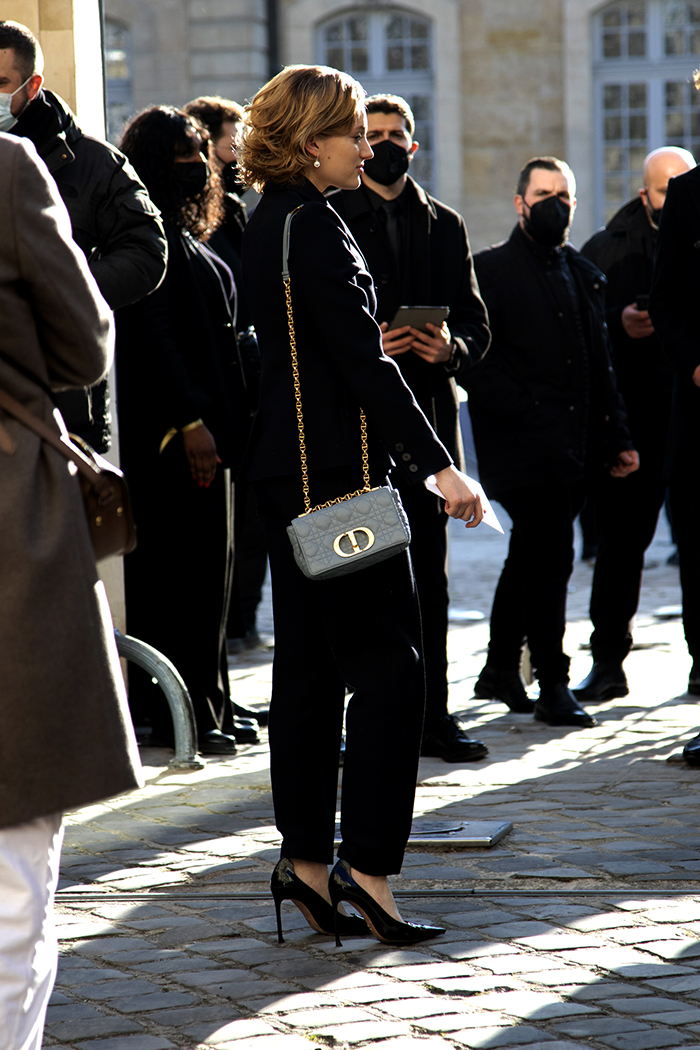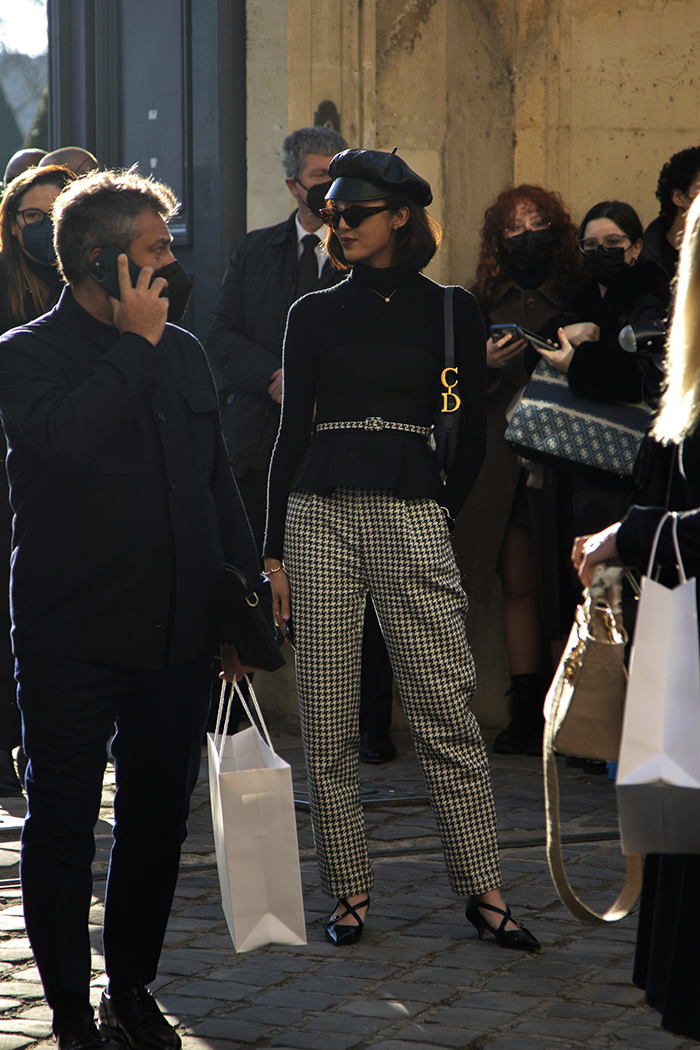 |
| Gabrielle 'Coco' Chanel, circa 1930s, photograph by André Kertész.
Médiathèque de l’architecture et du patrimoine. Photo © Ministère
de la Culture – Médiathèque de l’architecture et du patrimoine,
Dist. RMN-Grand Palais / André Kertész. Courtesy of the National Gallery of Victoria |
A major new exhibition about Gabrielle Chanel has opened at the National Gallery of Victoria in Melbourne. This is the first show in Australia about the renowned French designer and her contribution to 20th century fashion. More than 230 garments, accessories and jewellery are on display, drawn from major public and private collections, reports Antonio Visconti  |
Anne Sainte-Marie in a Chanel suit, photograph by Henry Clarke, published in Vogue US,1955, retouched by ARCP. Paris Musées © Henry Clarke, Paris Musées / Palais Galliera / ADAGP. Copyright
Agency, 2021
|
ONE of the most influential designers of the twentieth century, Gabrielle Chanel introduced a sense of modernity into fashion that is still relevant today. Chanel began to reform women’s wardrobes by creating a new way of dressing, many pieces inspired by men's clothing. Her designs focused on comfort and function, a complete departure from the tight corsets and heavy skirts of the Victorian and Edwardian eras.
Chanel was also responding to the zeitgeist of the first decades of the 20th century when woman were advocating for greater social and economic independence. Gabrielle Chanel herself had escaped an extremely impoverished and provincial childhood to create a career that would lead to the highest echelons of both society and fashion.
"There is no bigger name in twentieth century fashion design than Gabrielle Chanel. Her originality, timelessness and elegance forged a radically modern vision of fashion and a singular style," says Tony Ellwood, director of the National Gallery of Victoria. "Gabrielle Chanel. Fashion Manifesto is expansive, visually sumptuous and reveals the achievements and enduring legacy of the extraordinary French fashion designer."
This exhibition was first presented in Paris last year, created by the Palais Galliera, with loans from the Direction du Patrimoine de Chanel, the fashion house's heritage department. There are also loans from major public museums and private collections and designs from the NGV's own collection. This includes recent acquisitions such as a white lace evening dress, from Spring/Summer 1933 and a shirred red-silk velvet and marabou-lined evening cape from 1924–26.
"There is no bigger name in 20th century fashion than Gabrielle Chanel. Her originality, timelessness and elegance forged a radically modern vision."
 |
Installation view of Gabrielle Chanel at NGV International, Melbourne Photo: Sean Fennessy. |
Chanel’s impact on the development of women's wear throughout the 20th century, the role of her designs in contemporary culture and her remarkable career are traced through more than 100 garments, organised both chronologically and thematically.
The clothes are combined with Chanel's other innovative creations including perfume, jewellery and accessory designs. Some of the most iconic pieces include black dresses, considered very modern tat the time, lace gowns, tailored wool jersey and tweed suits, beaded gowns and striking costume jewellery.
Chanel opened her first fashion boutique in Deauville in 1912. Six years later she was able to open her couture house at 31 Rue Cambon in Paris in 1918 (where the fashion house's headquarters are still located). Her designs were all about a minimalist kind of luxury that was free of heavy decoration and tailored so women could be both active and comfortable. She pioneered the use of jersey and tweed, drawing inspiration from menswear and sportswear, introduced the ‘little black dress’ and the well-cut suit as liberating ways for women to dress.
"From the beginning of her career, in
the early years of the 20th century, right up to her death in 1971,
Gabrielle Chanel defied the prevailing fashions of her time," comments Miren Arzalluz, director of the Palais Galliera. "Chanel’s
style was based on the principles of comfort and respect for the
female anatomy, but also on the details and chic elegance of her
designs.
"Chanel avoided unnecessary decoration,
and her choice of colors, materials and techniques was always
judicious and bold, with an emphasis on balance and a harmonious
overall effect. Her garments had a sophisticated restraint that acted
as a contrast to the opulence of her jewellery, which was inspired by
ancient or distant civilizations and also her way of wearing an
abundance of it."
Chanel's designs offered a minimalist luxury that was free of heavy decoration and well-cut so women could be active and feel comfortable
 |
Installation view of Gabrielle Chanel. Fashion Manifesto at NGV International, Melbourne. Photo: Sean Fennessy
|
The clothes and accessories in the NGV exhibition date from 1910 to 1971 and show how Chanel's brought about changes in what women wear.
"All of her life, Gabrielle Chanel was at
the crossroads of fashion and the artistic avant-garde," explains Bruno Pavlovsky, president of Chanel Fashion.
"By
placing her own needs, her own desires and her own lifestyle at the
heart of her creative work, she was a pioneer in the advancement of
women and their place in society.
"Right from the beginning, in 1910,
her take on fashion became a manifesto for liberating women’s
bodies from the physical constraints of the prevailing fashions,
giving women the freedom at last to wear clothes in
which they could move about easily, whether in sports or at work ~ clothes in which a woman could now feel truly independent. "
Highlights of the exhibition include
rare examples of Chanel’s early daywear and her wool jersey suits,
which marked a radical departure from the elaborate fashions of the
Belle Epoque and Edwardian periods in France and England. Equally captivating are the gowns
associated with Chanel’s so-called ‘romantic’ period in the
1930s. Dedicated sections of the exhibition showcase Chanel’s
love and use of floral motifs, printed as textiles or as
appliqued florets, and her lace eveningwear.
"All of her life, Gabrielle Chanel was at the crossroads of fashion and the artistic avant-garde."
 |
Behind the scenes: garments being prepared for the Gabrielle Chanel. Fashion Manifesto exhibition at the NGV International. Photo: Eddie Jim |
Chanel’s innovations also included
the perfume, Chanel N°5, created in
1921, cosmetics and highly decorative costume jewellery that combined
precious and semi-precious materials.
The exhibition explores
the design motifs Chanel introduced in the 1950s, including the
quilted 2.55 bag and two-tone sling back that remain closely
associated with Chanel as Parisian fashion house.
A further highlight of the exhibition
is a display of iconic Chanel suits. Debuted by Chanel in the 1910s
and reintroduced after the re-opening of her haute couture house in
1954, the two and three- piece suits, in lightweight woven tweed or
wool bouclé, remains a feature of the house’s collections
to this day.
In the latter part of her career, Chanel's suits were worn by high profile women such as First Lady Jacqueline
Kennedy and Princess Grace of Monaco. Even earlier, actresses such as Marlene
Dietrich, and Lauren Bacall had begun to wear her designs. Eventually, the Chanel suit became a symbol of sophistication and one of the most identifiable designs of the label. Today, the suits are still defined by their exquisite tailoring allowing a great freedom of movement, the signature double "C" gilt buttons and the contrasting braiding along the cuffs and lapels.
Timeline of key events in Gabrielle Chanel's life and career:
 |
‘Coco’ Chanel at the Ritz Hotel (drawings by Christian Bérardand Jean Cocteau),1937, photograph by François Kollar. Médiathèque de l’architecture et du patrimoine. © Jean Cocteau / ADAGP. Copyright
Agency, 2021. Photo © Ministère de la Culture Médiathèque de l’architecture et du patrimoine, Dist. RMN-Grand Palais / François Kollar. Courtesy of the National Gallery of Victoria
|
1883 ~ Gabrielle Chanel is born at the charity
hospital in Saumur (Maine-et-Loire), on 19 August.
1903 ~ She begins working as an assistant,
alongside her aunt Adrienne, in a draper’s shop in Moulins
(Allier).
1909 ~ Chanel opens a milliner’s shop at
160, boulevard Malesherbes in Paris, with the assistance of
experienced milliner Lucienne Rabaté.
1910 ~ The millinery boutique ‘Chanel –
Modes’ opens in Paris at 21, rue Cambon.
1912 ~ Chanel opens another milliner’s shop
in Deauville. She soon branches out, adding a sportswear range,
including sailor-collar tops, jackets and blouses.
1915 ~ During the war, Chanel opens her
first couture house, in Biarritz, in a townhouse located opposite the
casino. At the time, the Basque Coast attracts a rich cosmopolitan
clientele.
1916 ~ Gabrielle Chanel creates a collection
of garments in knitted jersey, sourced from Rodier.
1918 ~ Gabrielle Chanel opens a couture
house at 31, rue Cambon in Paris, the iconic address that will
forever be associated with her name.
1921 ~ The perfume Chanel N°5 is created in
Grasse with Ernest Beaux, a Russian-born French perfumer.
1923 ~ Chanel buys the building at 29, rue
Cambon. A Chanel boutique opens in Cannes.
1924 ~ Chanel meets Pierre and Paul
Wertheimer. On 4 April, they enter into a partnership and form the
Société des Parfums Chanel. Chanel creates her first makeup range. In the same year, Chanel opens a costume
jewellery department in her Paris couture house. The jewellery is
made by Comte Étienne de Beaumont. She designs the costumes for the ballet
Le Train Bleu, which has a libretto by Jean Cocteau.
1926 ~ Chanel’s ‘little black dress’ is
nicknamed the ‘Ford’ dress by Vogue US.
1927 ~ A Chanel fashion house opens in London.
The perfume Cuir de Russie is launched. Launch of the first Chanel
skincare range, which includes 15 products.
1928 ~ Chanel opens a textile factory in
Asnières-sur-Seine, near Paris, under the brand name Tissus Chanel,
incorporating Tricots Chanel. The perfume Bois des Îles is launched.
1931 ~ Chanel signs a contract worth a million
dollars a year with American film producer Samuel Goldwyn. She is
contracted to create costumes for his Hollywood films.
1932 ~ Launch of the ‘Bijoux de Diamants’
fine jewellery collection. It is exhibited from 7~19 November
at Chanel’s apartment at 29, rue du Faubourg-Saint-Honoré.
1936 ~ During a general strike in France,
Chanel workers go on strike and occupy the rue Cambon premises.
1939 ~ When France declares war, the Maison
Chanel closes its doors. The weavers are called up and the Tissus
Chanel factory is forced to close; but the boutique selling perfumes
and accessories (31, rue Cambon) remains open
throughout the war.
1944 ~ Gabrielle Chanel is arrested at the
Ritz by the French Forces of the Interior because of her relationship
with a German officer, Baron Hans Günther von Dincklage. She is
released after a brief interrogation. For the next ten years, Chanel
lives away from the world of fashion, dividing her time between
Lausanne, Paris, and La Pausa (her villa on the French Côte d’Azur),
with trips to Italy and the USA.
 |
Gabrielle Chanel, photograph by Henry
Clarke, published in Vogue France, 1954. Paris Musées. © Henry Clarke, Paris
Musées /Palais Galliera/ADAGP. Copyright
Agency, 2021 |
1952 ~ On 7 April, Life magazine interviews
Marilyn Monroe, who responds to the question ‘What do you wear to
bed?’ with the answer ‘I only wear Chanel N°5.’
1953 ~ The couture house reopens after
fourteen years.
1954 ~ Chanel unveils her new couture
collection on 5 February. She is seventy-one years old.
1955 ~ In February, Chanel creates a quilted
lamb’s leather handbag with a chain shoulder strap, and names it
the 2.55 bag.
1957 ~ The first two-tone shoe is produced by
Chanel in collaboration with the shoemaker Massaro. Chanel receives
the Neiman Marcus Award for Distinguished Service in the Field of
Fashion, an award created by American businessman Stanley Marcus,
proprietor of luxury store Neiman Marcus in Dallas. Chanel is
honoured as ‘the most influential female designer of the 20th
century’.
1961 ~ Chanel creates the costumes worn by
French actress Delphine Seyrig in Alain Resnais’s film Last Year in
Marienbad.
1963 ~ On 22 November, the day that US
president John F. Kennedy is assassinated in Dallas, Jackie Kennedy
wears a pink Chanel suit from the Autumn–Winter 1961 collection.
1969 ~ On 18 December, the musical Coco opens
at the Mark Hellinger Theatre in New York. Katharine Hepburn plays
the role of Gabrielle Chanel.
1971 ~ On 10 January, Gabrielle Chanel dies in
Paris, in her suite at the Ritz. She is buried in Bois-de-Vaux
Cemetery, in Lausanne.
Gabrielle Chanel. Fashion Manifesto is
on at the NGV International, Melbourne, from 4 December 2021 ~ 25
April 2022.






















































